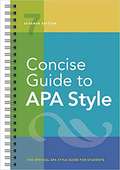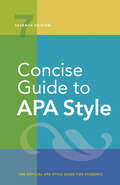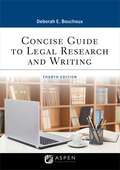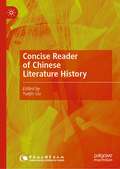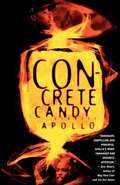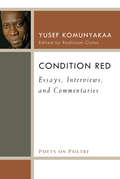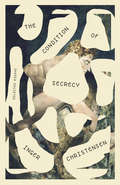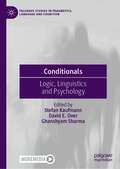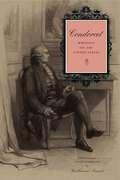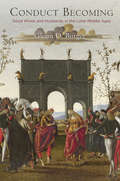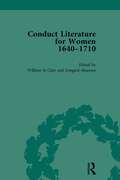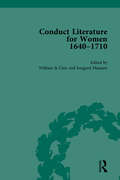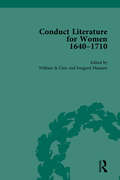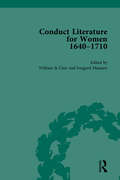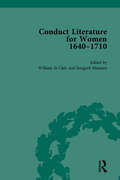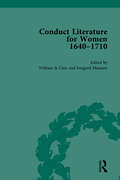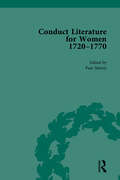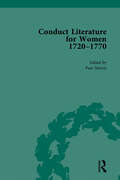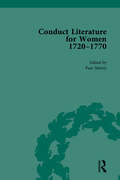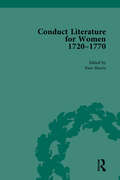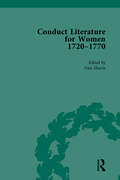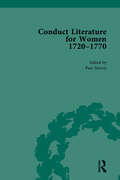- Table View
- List View
Concise Guide to APA Style
by American Psychological AssociationConcise Guide to APA Style, Seventh Edition is the official APA Style resource for students. Designed specifically for undergraduate writing, this easy-to-use pocket guide is adapted from the seventh edition of the Publication Manual of the American Psychological Association. It provides complete guidance for new writers on effective, clear, and inclusive scholarly communication and the essentials of formatting papers and other course assignments. New to This Edition: full color throughout content relevant to a range of majors and courses, including psychology, social work, criminal justice, communications, composition, education, business, engineering, and more a new chapter focused on student papers a sample student title page, paper, and annotated bibliography streamlined APA Style headings and in-text citations a new chapter on writing style and grammar chapters on punctuation, lists, italics, spelling, capitalization, abbreviations, numbers, and statistics the latest bias-free language guidelines new sample tables and figures guidance on avoiding plagiarism and self-plagiarism new reference templates and examples
Concise Guide to APA Style: 7th Edition (OFFICIAL)
by American Psychological AssociationConcise Guide to APA Style, Seventh Edition is the official APA Style resource for students. Written for high school and undergraduate students, instructors, and writers learning APA Style, this easy-to-use pocket guide is adapted from the seventh edition of the Publication Manual of the American Psychological Association. It provides complete guidance for new writers on effective, clear, and inclusive scholarly communication and the essentials of formatting papers and other course assignments. The seventh edition has been thoroughly revised and updated to reflect best practices in scholarly writing and publishing. Full color throughout Content relevant to a range of majors and courses, including psychology, social work, criminal justice, communications, composition, education, business, engineering, and more New chapter focused on student papers Sample student title page, paper, and annotated bibliography Streamlined APA Style headings and in-text citations New chapter on writing style and grammar Chapters on punctuation, lists, italics, spelling, capitalization, abbreviations, numbers, and statistics Latest bias-free language guidelines More than 20 new sample tables and figures Comprehensive guidelines on citation to help writers credit their sources appropriately and avoid plagiarism and self-plagiarism More than 100 new reference templates and examples, including traditional sources (e.g., journal articles, books, dissertations, and reports) plus many others (e.g., social media, webpages and websites, legal)
Concise Guide to APA Style: 7th Edition (OFFICIAL)
by American Psychological AssociationConcise Guide to APA Style, Seventh Edition is the official APA Style resource for students. Written for high school and undergraduate students, instructors, and writers learning APA Style, this easy-to-use pocket guide is adapted from the seventh edition of the Publication Manual of the American Psychological Association. It provides complete guidance for new writers on effective, clear, and inclusive scholarly communication and the essentials of formatting papers and other course assignments. The seventh edition has been thoroughly revised and updated to reflect best practices in scholarly writing and publishing. Full color throughout Content relevant to a range of majors and courses, including psychology, social work, criminal justice, communications, composition, education, business, engineering, and more New chapter focused on student papers Sample student title page, paper, and annotated bibliography Streamlined APA Style headings and in-text citations New chapter on writing style and grammar Chapters on punctuation, lists, italics, spelling, capitalization, abbreviations, numbers, and statistics Latest bias-free language guidelines More than 20 new sample tables and figures Comprehensive guidelines on citation to help writers credit their sources appropriately and avoid plagiarism and self-plagiarism More than 100 new reference templates and examples, including traditional sources (e.g., journal articles, books, dissertations, and reports) plus many others (e.g., social media, webpages and websites, legal)
Concise Guide to Legal Research and Writing (Aspen Paralegal Series)
by Deborah E. BouchouxFeaturing Deborah E. Bouchoux s highly regarded assignments, examples, and building-block approach, Concise Guide to Legal Research and Writing, Fourth Edition continues to provide timely coverage of the essential research and writing skills used by today's paralegals. Designed specifically for paralegal students, this is the ideal text for shorter legal research and writing courses. <p><p> New to the Fourth Edition: <p> <p>New Sidebar feature in all research chapters provides quick tips showing how the material in that chapter applies to computer-assisted legal research systems, such as Lexis, Westlaw, and Bloomberg Law. <p>Discussion of GovInfo, which provides free public access to official and authenticated publications from all three branches of the federal government. <p>Coverage of new tools used for cite-checking, including EVA and Bestlaw. <p>Discussion of Westlaw Edge, Westlaw s new research platform. <p>Extensive new coverage of the increasing use of artificial intelligence in legal research and writing. <p>Discussion of new sources that provide free public access to the law, including Harvard's Caselaw Access Project, CourtListener, and RECAP Project. <p>New sections on preparing email letters and email memoranda, including assignments. All new Research Questions and Internet Legal Research Assignments have been included for each chapter. <p><p>Professors and students will benefit from: <p> Concise, well-organized text, divided into six main sections: <ul style="list-style-type: circle;"> <li>Section I discusses primary authorities</li> <li>Section II covers secondary sources</li> <li>Section III focuses on computer-assisted legal research using Lexis Advance, Westlaw, and the Internet</li> <li>Section IV covers citation form and how to ensure that these sources are still good law</li> <li>Section V provides an overview of the legal research process</li> <li>Section VI covers legal writing</li> </ul> <p>Pedagogy designed to enhance the accessibility of the material, including helpful charts and diagrams that synthesize complex topics, updated Practice Tips offering realistic and helpful suggestions for workplace success, and Ethics Alerts in every chapter. <p>Targeted and ample exercises help students learn how to use a wide range of research sources. <p>Tips on how to effectively use electronic resources are included throughout the text. <p>Conscientious revision ensures that the book has the most up-to-date material, presented in a readable and accessible format.
Concise Reader of Chinese Literature History
by Yuejin LiuThis book includes the history of Chinese literature before 1949. It firstly outlines the development process of Chinese literature and basic features and then discusses them according to the literary genre, for the literature of each era. This book gathers established scholars in the field and presents their latest research in the Chinese literature history studies. Moreover, it has included the literature history of different nationalities in the history of China and the records of folk literature history, reflecting literature from different classes. In the limited space of this book, the writers who have been loved by the Chinese people for three thousand years are discussed, such as Qu Yuan, Tao Yuanming, Li Bai, Du Fu, Su Shi, Xin Qiji, Yuan Haowen, Nalan Xingde, and so on. Careful elaborations are made on each writer together with quotations and analysis of their work.
Concise Thesaurus of Traditional English Metaphors
by Dick WilkinsonThis absorbing collection of metaphors includes a variety of expressions with figurative meanings, like similes, proverbs, slang and catchphrases. It is the result of a lifetime of work on dialect and metaphor and gives an overview of the folk wisdom expressed in figurative expressions. The author draws on his extensive contact with the rural cultures of Dorset, Cornwall, Yorkshire and Lancashire, but has also included a range of sayings from North America, Australia, Scotland and other English speaking countries. With revised contents and an improved index to make individual entries easier to find, the Concise can be used to check the meaning and the origin of an expression or to avoid mixed metaphors, anachronisms and incongruities. It is a joy to browse long after your original query has been answered.
Concrete Candy: Stories
by ApolloSix incendiary stories that reflect the rage and frustration -- and the determination to survive -- of America's disenfranchised inner-city youth. Concrete Candy marks the debut of an astonishing new writer -- notable both for the authenticity and immediacy of his voice and for his age: fifteen. Three years ago, Apollo, a child of the inner city and a protege of the acclaimed novelist Jess Mowry, began writing stories that reflect the tension, drama, and pathos of the urban reality he has lived and witnessed. The result is this collection of six powerful, haunting tales of boys dangerously adrift in the 'hood.
Condition Red: Essays, Interviews, and Commentaries
by Yusef Komunyakaa Radiclani ClytusCondition Red collects writing by one of America’s most gifted and revered poets, Yusef Komunyakaa. While themes from his earlier prose collection, Blue Notes, run through Condition Red, this volume expresses a greater sense of urgency about the human condition and the role of the artist. Condition Red includes his powerful letter to Poetry magazine, asserting that “we writers (artists) cannot forget that we are responsible for what we conjure and embrace through language, whether in essays, novels, plays, poems, or songs.” Also included are essays and interviews on: coming home to Bogalusa, Louisiana; the influence of religion on black poetry; language and eroticism; the visual artist Floyd Tunson; and the poets Robert Hayden, Walt Whitman, Clarence Major, and Etheridge Knight. The book features an extended introduction by editor Radiclani Clytus, who concludes that “Condition Red issues readers much more than a critical warning; it reminds us that our innate cultural capacity for language is, and always has been, the sum total of that which defines us.”
Condition of Secrecy
by Inger ChristensenFor the first time available in English, a selection of some of Inger Christensen’s most insightful essays and poetic prose pieces The Condition of Secrecy is a poignant collection of essays by Inger Christensen, widely regarded as one of the most influential Scandinavian writers of the twentieth century. As The New York Times proclaimed, “Despite the rigorous structure that undergirds her work—or more likely, because of it—Ms. Christensen’s style is lyrical, even playful.” The same could be said of Christensen’s essays. Here, she formulates with increasing clarity the basis of her approach to writing, and provides insights into how she composed specific poetry volumes. Some essays are autobiographical (with memories of Christensen’s school years during the Nazi occupation of Denmark), and others are political, touching on the Cold War and Chernobyl. The Condition of Secrecy also covers the Ars Poetica of Lu Chi (261-303 CE); William Blake and Isaac Newton; and such topics as randomness as a universal force and the role of the writer as an agent of social change. The Condition of Secrecy confirms that Inger Christensen is “a true singer of the syllables” (C. D. Wright), and “a formalist who makes her own rules, then turns the game around with another rule” (Eliot Weinberger).
Conditionals: Logic, Linguistics and Psychology (Palgrave Studies in Pragmatics, Language and Cognition)
by Stefan Kaufmann David E. Over Ghanshyam SharmaThis edited book examines conditionals from a number of interdisciplinary perspectives, drawing on research from fields as diverse as linguistics, psychology, philosophy and logic. Across 13 chapters, the authors not only investigate and examine various commonly-held perceptions about conditionals, but they also challenge many of the assumptions underpinning current conditionals scholarship, setting an agenda for future research. Based in part on the papers presented at a unique international summer school - Conditionals in Paris - this volume represents the cutting edge in the study of conditionals, and it will be of interest to scholars in fields including linguistics and psychology, semiotics, philosophy and logic, and artificial intelligence.
Condorcet: Writings on the United States
by Guillaume AnsartCondorcet (1743–1794) was the last of the great eighteenth-century French philosophes and one of the most fervent américanistes of his time. A friend of Franklin, Jefferson, and Paine and a member of the American Philosophical Society, he was well informed and enthusiastic about the American Revolution. Condorcet’s writings on the American Revolution, the Federal Constitution, and the new political culture emerging in the United States constitute milestones in the history of French political thought and of French attitudes toward the United States. These remarkable texts, however, have not been available in modern editions or translations. This book presents first or new translations of all of Condorcet’s major writings on the United States, including an essay on the impact of the American Revolution on Europe; a commentary on the Federal Constitution, the first such commentary to be published in the Old World; and his Eulogy of Franklin, in which Condorcet paints a vivid picture of his recently deceased friend as the archetype of the new American man: self-made, practical, talented but modest, tolerant and free of prejudice—the embodiment of reason, common sense, and the liberal values of the Enlightenment.
Condorcet: Writings on the United States
by Guillaume AnsartCondorcet (1743–1794) was the last of the great eighteenth-century French philosophes and one of the most fervent américanistes of his time. A friend of Franklin, Jefferson, and Paine and a member of the American Philosophical Society, he was well informed and enthusiastic about the American Revolution. Condorcet’s writings on the American Revolution, the Federal Constitution, and the new political culture emerging in the United States constitute milestones in the history of French political thought and of French attitudes toward the United States. These remarkable texts, however, have not been available in modern editions or translations. This book presents first or new translations of all of Condorcet’s major writings on the United States, including an essay on the impact of the American Revolution on Europe; a commentary on the Federal Constitution, the first such commentary to be published in the Old World; and his Eulogy of Franklin, in which Condorcet paints a vivid picture of his recently deceased friend as the archetype of the new American man: self-made, practical, talented but modest, tolerant and free of prejudice—the embodiment of reason, common sense, and the liberal values of the Enlightenment.
Conduct Becoming: Good Wives and Husbands in the Later Middle Ages
by Glenn D. BurgerConduct Becoming examines a new genre of late medieval writing that focuses on a wife's virtuous conduct and ability of such conduct to alter marital and social relations in the world. Considering a range of texts written for women—the journées chrétiennes or daily guides for Christian living, secular counsel from husbands and fathers such as Le Livre du Chevalier de La Tour Landry and Le Menagier de Paris, and literary narratives such as the Griselda story—Glenn D. Burger argues that, over the course of the long fourteenth century, the "invention" of the good wife in discourses of sacramental marriage, private devotion, and personal conduct reconfigured how female embodiment was understood.While the period inherits a strongly antifeminist tradition that views the female body as naturally wayward and sensual, late medieval conduct texts for women outline models of feminine virtue that show the good wife as an identity with positive influence in the world. Because these manuals imagine how to be a good wife as necessarily entangled with how to be a good husband, they also move their readers to consider such gendered and sexed identities in relational terms and to embrace a model of self-restraint significantly different from that of clerical celibacy. Conduct literature addressed to the good wife thus reshapes how late medieval audiences thought about the process of becoming a good person more generally. Burger contends that these texts develop and promulgate a view of sex and gender radically different from previous clerical or aristocratic models—one capable of providing the foundations for the modern forms of heterosexuality that begin to emerge more clearly in the fifteenth and sixteenth centuries.
Conduct Literature for Women, Part II, 1640-1710 vol 1
by William St Clair Irmgard MaassenThis collection aims to give a chronological insight into the evolution of conduct literature, from its early roots in the Renaissance period through to the dramatically different role that women played at the emergence of the 20th century.
Conduct Literature for Women, Part II, 1640-1710 vol 2
by William St Clair Irmgard MaassenThis collection aims to give a chronological insight into the evolution of conduct literature, from its early roots in the Renaissance period through to the dramatically different role that women played at the emergence of the 20th century.
Conduct Literature for Women, Part II, 1640-1710 vol 3
by William St Clair Irmgard MaassenThis collection aims to give a chronological insight into the evolution of conduct literature, from its early roots in the Renaissance period through to the dramatically different role that women played at the emergence of the 20th century.
Conduct Literature for Women, Part II, 1640-1710 vol 4
by William St Clair Irmgard MaassenThis collection aims to give a chronological insight into the evolution of conduct literature, from its early roots in the Renaissance period through to the dramatically different role that women played at the emergence of the 20th century.
Conduct Literature for Women, Part II, 1640-1710 vol 5
by William St Clair Irmgard MaassenThis collection aims to give a chronological insight into the evolution of conduct literature, from its early roots in the Renaissance period through to the dramatically different role that women played at the emergence of the 20th century.
Conduct Literature for Women, Part II, 1640-1710 vol 6
by William St Clair Irmgard MaassenThis collection aims to give a chronological insight into the evolution of conduct literature, from its early roots in the Renaissance period through to the dramatically different role that women played at the emergence of the 20th century.
Conduct Literature for Women, Part III, 1720-1770 vol 1
by Pam MorrisThe material presented in this six-volume set moves away from courtly etiquette, adopting a more middle-class, domestic focus, and includes facsimile reproductions of sermons, poems, narratives and cookery books.
Conduct Literature for Women, Part III, 1720-1770 vol 2
by Pam MorrisThe material presented in this six-volume set moves away from courtly etiquette, adopting a more middle-class, domestic focus, and includes facsimile reproductions of sermons, poems, narratives and cookery books.
Conduct Literature for Women, Part III, 1720-1770 vol 3
by Pam MorrisThe material presented in this six-volume set moves away from courtly etiquette, adopting a more middle-class, domestic focus, and includes facsimile reproductions of sermons, poems, narratives and cookery books.
Conduct Literature for Women, Part III, 1720-1770 vol 4
by Pam MorrisThe material presented in this six-volume set moves away from courtly etiquette, adopting a more middle-class, domestic focus, and includes facsimile reproductions of sermons, poems, narratives and cookery books.
Conduct Literature for Women, Part III, 1720-1770 vol 5
by Pam MorrisThe material presented in this six-volume set moves away from courtly etiquette, adopting a more middle-class, domestic focus, and includes facsimile reproductions of sermons, poems, narratives and cookery books.
Conduct Literature for Women, Part III, 1720-1770 vol 6
by Pam MorrisThe material presented in this six-volume set moves away from courtly etiquette, adopting a more middle-class, domestic focus, and includes facsimile reproductions of sermons, poems, narratives and cookery books.
